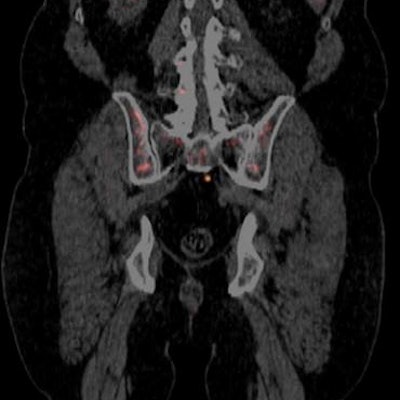
In September 2013, Medicare coverage for new oncologic PET radiopharmaceuticals underwent a quiet yet significant change. Up to this point, any new PET radiopharmaceuticals were required to go through a national coverage determination (NCD) for Medicare coverage.
While this Medicare coverage was national when granted, the NCD process itself was lengthy and had resulted in coverage with evidence development (CED) study requirements for new PET coverage requests since 2005, such as the National Oncologic PET Registry (NOPR) or the Imaging Dementia - Evidence for Amyloid Scanning (IDEAS) study.
 Terri Wilson from Blue Earth Diagnostics.
Terri Wilson from Blue Earth Diagnostics.The NCD process was significantly different and more cumbersome than the coverage pathway for therapeutic or gamma-emitting radiopharmaceuticals used in general nuclear medicine. In fact, a national coverage analysis typically takes nine to 12 months after approval of the new PET radiopharmaceutical by the Food and Drug Administration (FDA).
What was the change? In 2013, in response to a formal request by the PET industry led by the Medical Imaging and Technology Alliance (MITA) PET Group and after nearly two years of dialogue, the Centers for Medicare and Medicaid Services (CMS) added the following language to the NCD to apply to its Medicare administrative contractors (MACs):
Effective for dates of service on or after March 7, 2013, MACs may determine coverage within their respective jurisdictions for positron emission tomography (PET) using radiopharmaceuticals for their Food and Drug Administration (FDA) approved labeled indications for oncologic imaging.
This new language allowed manufacturers to request coverage from the local MACs upon FDA approval of the new oncologic PET radiopharmaceutical. Before the change, the local MACs could not cover a new PET radiopharmaceutical until CMS had issued specific instructions about which patients and indications would be covered and details about submitting claims for the scan. Allowing the local MACs to make the determination had the potential to cut months and in some cases years off the length of time from FDA approval to Medicare beneficiary access.
How is it working? Three new PET radiopharmaceuticals have been approved since the effective date: C-11 choline in 2012, Axumin (fluciclovine F-18) on May 27, 2016, and Netspot (gallium-68 DOTATATE) on June 2, 2016. The ability to work directly with the local MACs has enabled effective national coverage in a shorter period. For the latter two products, all MACs granted coverage in less than six months after FDA approval, a reduction of at least four months from the NCD model. This is not only a win for the PET industry, it is a win for the patients who benefit from faster access to these new imaging tests.
In addition to enabling faster coverage of new PET radiopharmaceuticals, CMS also created 5 new A-codes for PET radiopharmaceuticals; three for the new products and two for "not-otherwise-classified PET radiopharmaceuticals" (see table below). Quickly receiving product-specific A-codes allows all imaging providers to bill with the specific coding to all types of payers, reducing confusion, questions, and inappropriate denials by payers. And the creation of two not-otherwise-classified PET radiopharmaceutical codes will reduce the coding burden during the first year(s) after FDA approval for next new PET radiopharmaceuticals.
| PET radiopharmaceuticals with new A-codes | |
| A9515 | Choline C-11, diagnostic, per study dose, up to 20 mCi |
| A9587 | Gallium Ga-68 DOTATATE, diagnostic, 0.1 mCi |
| A9588 | Fluciclovine F-18, diagnostic, 1 mCi |
| A9597 | PET radiopharmaceutical, diagnostic, for tumor identification, not otherwise classified |
| A9598 | PET radiopharmaceutical, diagnostic, for nontumor identification, not otherwise classified |
Of course, Medicare coverage and coding are only the beginning. Payment rates under the Medicare Outpatient Prospective Payment System (OPPS) after the transitional pass-through period remains a challenge. More work is also necessary to ensure coverage with all the commercial payers, and the manufacturers continue to work with providers on this.
Overall, 2016 was a great year for new oncologic PET radiopharmaceuticals and the Medicare beneficiaries who will benefit from these scans.
References
- Medicare National Coverage Determinations Manual. Centers for Medicare and Medicaid Services website. https://www.cms.gov/Regulations-and-Guidance/Guidance/Manuals/downloads/ncd103c1_part4.pdf. Accessed February 7, 2017.
- Healthcare Common Procedure Coding System 2017 File. Centers for Medicare and Medicaid Services website. https://www.cms.gov/Medicare/Coding/HCPCSReleaseCodeSets/Alpha-Numeric-HCPCS-Items/2017-Alpha-Numeric-HCPCS-File.html. Accessed February 7, 2017.
Terri Wilson is the former director of molecular imaging/PET at the Medical Imaging and Technology Alliance. She currently serves as director of patient access and healthcare policy at Blue Earth Diagnostics, the manufacturer of Axumin.
The comments and observations expressed herein are those of the author and do not necessarily reflect the opinions of AuntMinnie.com.




















